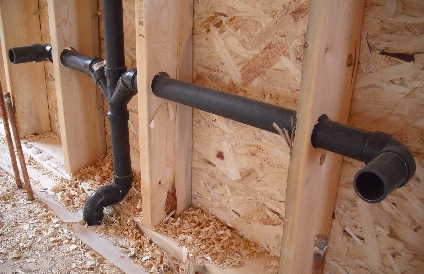
Potential friction points:
First hole, top left
second hole, bottom right
|
WHAT CAN BE DONE ABOUT IT
Nothing, unless you want to spend a fortune to locate the problem areas and fix it. But even after major "wall surgery" there will still be plumbing sounds in your home. Learn to live with it. In all likelihood the sounds have been there since the home was built.
Have a look at the picture. The opening in the wall studs are large enough but the ABS drain is touching the wood in some places as they pass through wall studs. These friction points could make clicking sounds when a lot of hot water is used or drained. Snapping and clicking sounds can be prevented from occurring if a rubber or foam sleeve is attached to the pipes where it passes through studs and joists. The sleeve will absorb vibrations and helps to stop or reduce noise transmission.
|
|
Snapping or Clicking Plumbing Sounds
Usually when a lot of hot water is used |
|
|
Just about every house "talks". Some of the plumbing noises have been there from the time the house was built while others were "activated" during renovations. Some of the sounds can be fixed while others can't. A most annoying plumbing sound is that of water cascading down the main stack in a wall adjacent to the living or dining room wall every time the upstairs toilet is flushed.
Water hammer sounds can be fixed without opening walls. Snapping or clicking sounds can also be annoying but they last only for short periods of time. Fixing it is next to impossible unless you are willing to spend a lot of money locating the problem areas by opening walls and/or ceilings.
WHEN DO YOU HEAR IT?
It seems that the only time you will hear the snapping or clicking sound is when hot water is used. If you listen carefully you will notice that the sound is mainly coming from the drain area and not from the water supply lines. In my own home I fill up the vanity sink with hot water and mix in a cup of dishwashing liquid, then pull the drain stopper. Doing this periodically ensures that the drain will stay open. I do not hear any snapping or clicking sound when filling the basin with hot water, so it is not coming from the water supply lines. I only hear it when I pull the stopper indicating to me that the problem is in the drain pipe.

Plumbing rough-in for double vanity sink drains. The drilled holes in the 2x6
are large enough to accommodate the drain pipes. However, the pipes are
not installed in the centre of the opening and could create snapping or
clicking sounds when a lot of hot water is used. |
|
|
|
WHAT IS CAUSING THE CLICKING SOUND?
In a perfect world holes for plumbing pipes are slightly oversized and the pipes are installed in the center of the hole so water pipes and drains can expand and contract freely.
Lets have a closer look at what is going on in the drain pipe just before the vanity sink is filled with hot water and right after it is drained. When the sink is not used the drain is cold. As soon as the sink is drained the drain pipe expands due to the hot water flowing through it. As it expands in size the pipe "slides" against the wood and you hear the snapping sound. After the water has passed the drain pipe contracts back to its original size. This ongoing expand/contract cycle for a solid material like ABS pipe is not unusual. Even steel and concrete expands when exposed to warm or hot temperatures.
CAN IT HARM THE PIPES?
No. You do not have to worry about the snapping or clicking sounds. The natural expansions and contractions happens regardless of how well the pipes have been installed. The friction of the pipes against the wood is not harming the plumbing pipes.
NOTE
Both, ABS and PVC pipes are used for plumbing lines. Their use is regulated by code which is not the same for all jurisdictions. Sometimes both materials are approved for residential use in the same part of the country. |
|
|
|
|
Back to Top |
|